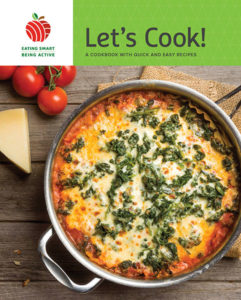A host of tools created at Colorado State University to help people lead a healthy lifestyle are now just a smartphone tap away.
A new app has been developed for Eating Smart • Being Active, the acclaimed curriculum developed a decade ago by a team led by CSU Professor and Extension Specialist Susan Baker of the Department of Food Science and Human Nutrition. Eating Smart • Being Active targets low-income families and is widely used by nutrition education programs in 41 states, Puerto Rico and Guam.
 Baker’s team developed the new smartphone application to reinforce the information and skills taught in the nine-lesson classes.
Baker’s team developed the new smartphone application to reinforce the information and skills taught in the nine-lesson classes.
“If class attendees want to review something they learned in the classes, they can refer to the app,” Baker explains, adding that eventually her team will be able to use the app to collect data on how well the information and new skills learned are maintained in the months and years after people finish the program.
Features in the app
In addition to a daily step tracker, the app features recipes found in the Eating Smart • Being Active “Let’s Cook!” Cookbook and includes shopping lists for each recipe. The app also has simple exercises taught in the classes that don’t require any special equipment and can be done anywhere. The exercises are demonstrated with simple gif animations that don’t burn data, which is an important consideration for anyone on a budget. Also included in the app is a unit price calculator, to help people quickly and easily find the cost-per-ounce of a food product, so that prices can be compared at the grocery store.
“Offering shopping lists on the app is a huge thing for people who are on really tight food budgets,” Baker says. “And if they get to the grocery store and realize they’ve forgotten their list, they can just bring up the shopping list in the app on their phone for one of our recipes.”
The app is available to Colorado State University Extension EFNEP (Expanded Food and Nutrition Education Program) class participants, but anyone can download it for free by searching for “Eating Smart Being Active” in the Apple App Store or Google Play for Android.
 Healthy, cheaper eating
Healthy, cheaper eating
“If we can get people cooking healthier at home instead of choosing a fast-food drive-through, they’ll not just eat better, but save money,” Baker says. “They need to have food in the house so they’re not tempted by fast food. That takes advance planning and new routines.
“People’s lives are very busy and it’s hard to stay on top of it all, so our approach is to make it very easy by giving them confidence, and eliminate the barriers to behavior change so that the healthy choice is the easy choice.”
Eating Smart • Being Active, updated in April, reflects the 2015-2020 Dietary Guidelines for Americans from the U.S. Department of Health and Human Services and the U.S. Department of Agriculture. In addition to the guideline changes, the curriculum helps low-income individuals learn how to cook healthy and inexpensive meals at home — and incorporate more physical activity into their daily routines. The 90-minute classes, taught by CSU Extension EFNEP educators at schools, health clinics and human service agencies, covers how to choose healthier foods, stretch food budgets and be more physically active. Cookbooks are free to all class participants, but individual copies of the Eating Smart • Being Active “Let’s Cook!” Cookbook can be purchased through CSU Extension at http://csuextstore.com.
